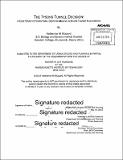The Tysons Tunnel decision : a case study of suboptimal decision-making in major transit investments
Author(s)
Blizzard, Katherine M. (Katherine Margaret)
DownloadFull printable version (15.35Mb)
Alternative title
Case study of suboptimal decision-making in major transit investments
Other Contributors
Massachusetts Institute of Technology. Department of Urban Studies and Planning.
Advisor
Lawrence Susskind.
Terms of use
Metadata
Show full item recordAbstract
In 2014 Washington, D.C.'s Metrorail system opened Phase 1 of its new Silver Line, which extends the current system to include significant portions of Fairfax County in Northern Virginia. This extension runs through Tysons Corner - a major regional business district that is notorious as a sprawling and auto-oriented "edge city" - on elevated tracks that are an average of 36 feet off the ground. Fairfax County hopes the Silver Line will help transform Tysons Corner into a true urban downtown that is walkable and transit-oriented. This goal, however, is shadowed by a heated debate that occurred between 2005 and 2008 over the "Tysons Tunnel," which was a proposal to build the Silver Line underground through Tysons Corner instead of the elevated design that was originally planned and ultimately built. The tunnel was widely popular and proponents believed it would more effectively transform Tysons Corner into a walkable, transit-oriented district, while the elevated design would only harm these goals by dividing the area with bulky infrastructure. Opponents did not disagree, but argued the tunnel's added costs would disqualify the entire Silver Line project from federal funding. The ensuing debate pitted all levels of government, local businesses, and community members against one another, until the elevated design gained final approval in 2008 due to a series of disputed political constraints. Still, the debate leaves serious questions about the Silver Line's ability to transform Tysons Corner with its elevated design. This thesis seeks to determine whether the decision against the Tysons Tunnel was optimal given the political and economic constraints faced at the time, or whether the decision was suboptimal and based on unfounded constraints. To this end, it explores in depth the history of the Tysons Tunnel debate, the perspectives of all major actors in the debate, and the elevated Silver Line's current impact on Tysons Corner. This investigation presents strong evidence that the prevailing reasons against the tunnel were based on unfounded constraints, particularly: flawed federal funding criteria, the political interests of high-level politicians in Virginia, and an uncompetitive contracting process. Further, the current impacts of the Silver Line in Tysons Corner are found to undermine the area's goals for transit-oriented development. The Tysons Tunnel decision, therefore, was suboptimal and has led to the problematic results that manifest today in Tysons Corner. To improve future decision-making processes in major transit investments, this thesis provides several recommendations for how the Federal Transit Administration can reframe its evaluation criteria and general outlook to become more supportive of local government interests and promote local transit investment in order to make the most out of limited federal funding for transit.
Description
Thesis: M.C.P., Massachusetts Institute of Technology, Department of Urban Studies and Planning, 2015. Cataloged from PDF version of thesis. Includes bibliographical references (pages 130-136).
Date issued
2015Department
Massachusetts Institute of Technology. Department of Urban Studies and PlanningPublisher
Massachusetts Institute of Technology
Keywords
Urban Studies and Planning.